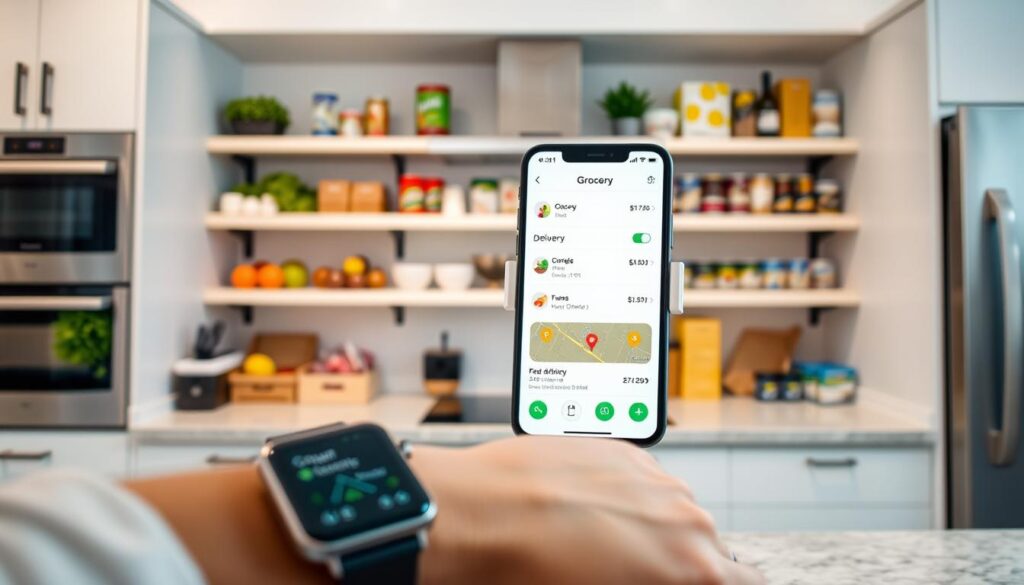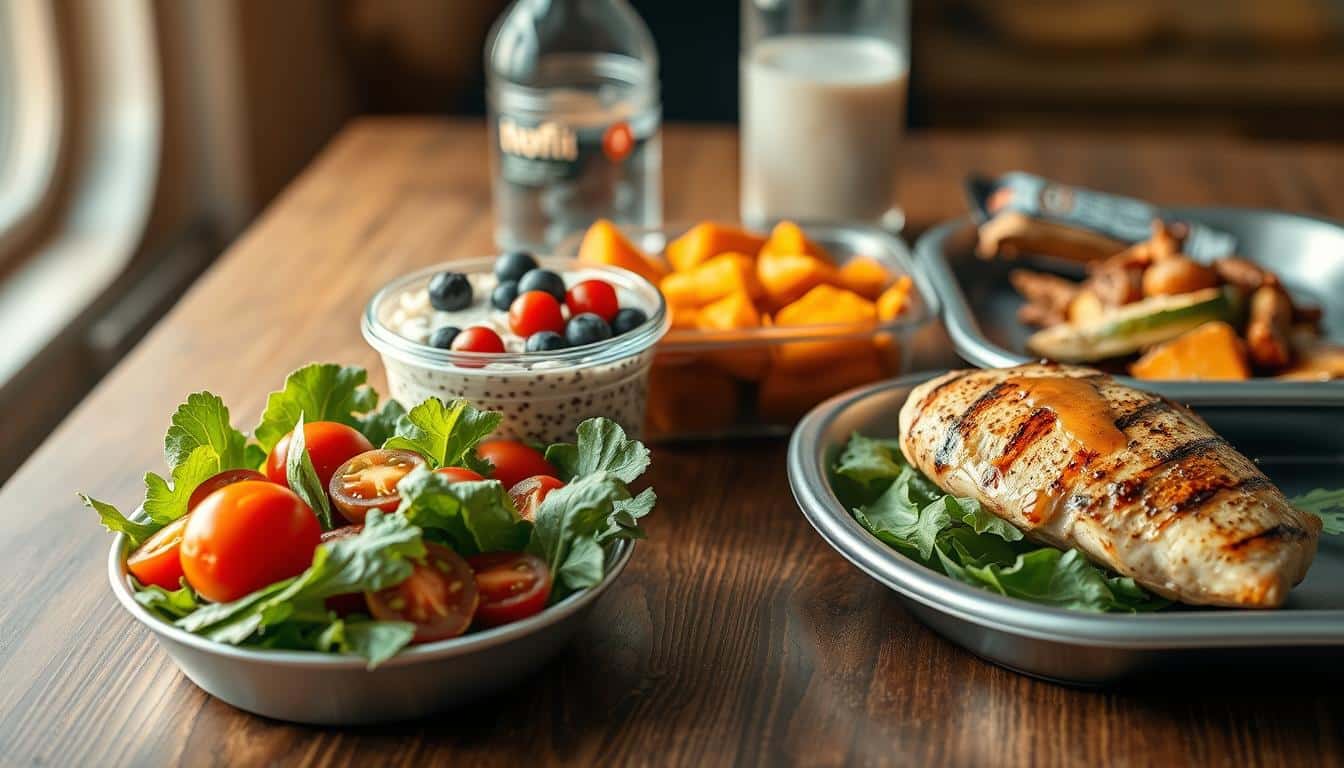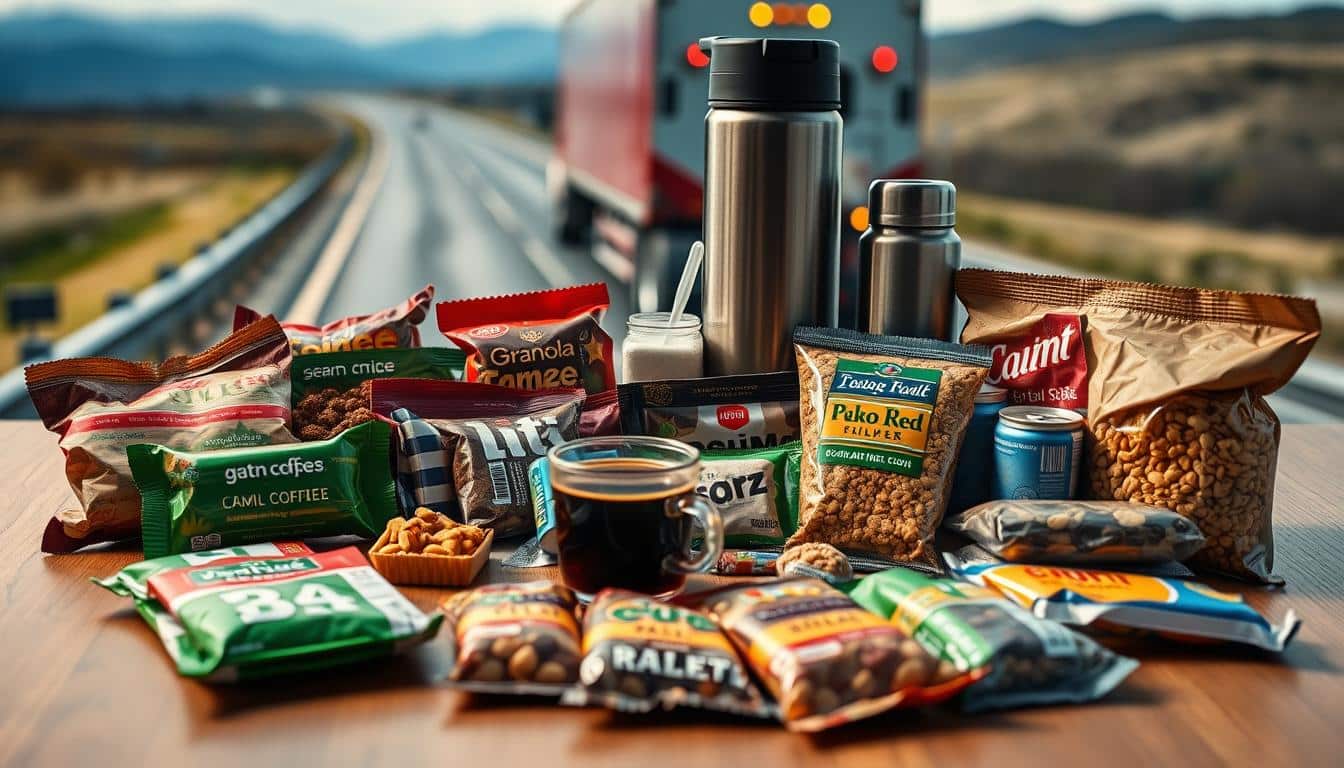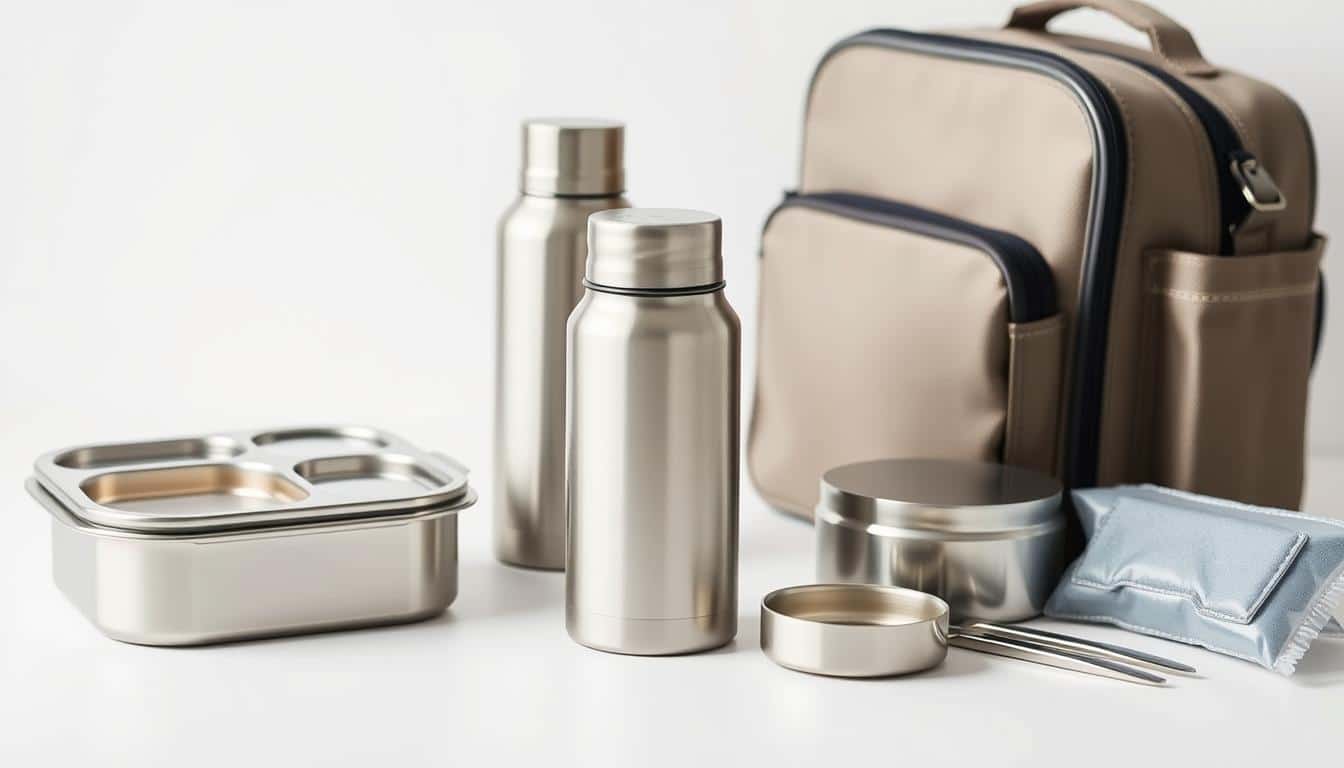A mobile food organizer is a tool designed for smartphones. It combines recipes, meal plans, pantry checks, grocery lists, and nutrition tracking. It’s an on-the-go meal planner that makes deciding what to eat easy anywhere. This is especially true when you’re commuting, at work, or in a grocery aisle.
Some top services include Samsung Food, Paprika, Mealime, PlateJoy, and Plan to Eat. These apps offer cool features like recipe clipping, cloud sync, and drag-and-drop calendars. They turn scattered notes and cookbooks into an organized collection of recipes.
For shoppers using Instacart, Kroger, or local delivery in the U.S., a mobile meal planner can be a game-changer. It cuts down on weekly planning time and helps avoid buying the same items again and again. This app also helps reduce food waste by using the right amount of ingredients for your recipes. People are switching from paper to apps because it saves time, reduces costs, and cuts down on waste.
Why a Mobile Food Organizer Changes How You Plan Meals
Mobile food organizers change the game by putting all your recipes in one spot. With your phone, making weekly menus and shopping lists happens in a snap. This makes cooking less of a chore and more of a breeze.
Time savings and streamlined planning
People save heaps of time by using planner apps. They come with cool features like recipe saving and easy meal building. Plan to Eat users even found they spent less time on meal planning and shopping each week.
Some apps, like Mealime, are great for choosing meals fast and making shopping lists quickly. With automated help, users see a real drop in the time they spend planning meals for their households.
Cost savings and reduced food waste
Smart planning can cut down your grocery bills. Plan to Eat noticed a drop in food costs for many after they switched to better meal management. Features that help you avoid buying the same thing twice reduce waste.
Apps that list ingredients and track what you already have make shopping more efficient. Tools in apps like MealBoard help you budget better and waste less food.
Health and nutrition tracking on the go
Tracking nutrition on your mobile means having diet details with you always. Apps like Samsung Food and PlateJoy work with fitness apps, fitting meals to your health goals anywhere.
By setting dietary needs in these apps, choosing healthier meals gets simpler. Having nutrition info with recipes means healthier eating through the week.
Core features to look for in a Mobile Food Organizer
A strong mobile food organizer should make meal planning fast and easy. It should let you save recipes from the internet easily. A good one will help you create a shopping list and keep to your diet. These features help turn your meal ideas into a weekly plan without stress.
What to expect from recipe saving and clipping
- Save recipes from sites with a recipe clipper that keeps source links and full ingredient lists.
- Edit and tag saved recipes for folders like “30 Minutes” or “Kids’ Favorites.”
- Some apps accept photo scans of printed recipes for quick capture.
Smart meal planning calendar and drag-and-drop scheduling
- A visual meal planning calendar should let you move meals between days with drag-and-drop ease.
- Calendars that support recurring meals, notes, and start-date changes speed up weekly prep.
- Reusable plans help when scheduling around events or family routines.
Automated grocery lists and shopping integrations
- A good organizer creates an automated grocery list when you add recipes to the calendar.
- Look for aisle-organized lists and options to export or send to delivery services.
- Some apps connect directly to grocery partners like Instacart or Amazon Fresh for one-step ordering.
Dietary filters and allergy avoidance settings
- Robust dietary filters let you choose diets such as vegan, keto, or Mediterranean and tailor suggestions.
- Allergy settings should flag or remove ingredients like nuts, dairy, or gluten across saved recipes.
- Advanced platforms use detailed surveys to match plans to lifestyle needs and health goals.
How to personalize meal plans for dietary goals and restrictions
Starting a meal plan means choosing what you eat and don’t eat carefully. Apps can help you pick your food preferences like being vegan or keto. You can also tell the app to skip foods you’re allergic to, like nuts or dairy.
These apps remember what you don’t like or what could be harmful. For instance, Samsung Food can keep track of many dietary restrictions easily.
Setting up your food goals is key. You start with how many calories you want and the balance of nutrients. Tools like Eat This Much and PlateJoy then create meal plans that stick to your calorie limit using a wide range of foods.
It’s also important to watch your macros for staying energetic and maintaining muscles. Apps such as MealPrepPro and PlateJoy help track these and work with fitness gadgets. MealPrepPro customizes your macro goals. Samsung Food helps by showing what’s in your food and how it fits your health.
If you have special dietary needs, like diabetes, there are specific features to look for. PlateJoy offers plans that are good for managing diabetes and even connects you with nutrition experts.
Families can work together on their meal plans with the right tools. Apps like Paprika make it easy to handle different dietary needs and shopping lists all in one. This makes planning meals for the week simpler for everyone.
- Set dietary preferences and avoidances to filter recipes and groceries.
- Use calorie goals and macro tracking to shape portion sizes and meal timing.
- Choose apps with diabetic meal planning features and allergy-safe substitutions.
Top use cases: who benefits most from a Mobile Food Organizer
Mobile food organizers are great for different life styles. Here are some common situations where they help a lot.
For busy professionals and those always on the move, time is key. Apps like Mealime and Paprika offer 30-minute meals. They also make it easy to manage grocery lists and access info on any device. This keeps meal planning simple, even when you’re on the go or in meetings.
Meal preppers and those who cook in bulk find great tools for their needs. MealPrepPro and BigOven have special features for big meals. They help with nutrition info and adjusting ingredients. This helps make cooking days efficient and lets you easily plan shopping for lots of meals.
Families and those living with others know the importance of teamwork. Plan to Eat and Samsung Food offer ways to work together on meal plans. You can share calendars, save favorites, and make shopping lists together. These tools make it easier to manage meals, keeping everyone happy and organized.
- Time-savers: quick recipe selection and synced lists for commuters.
- Prep efficiency: batch-friendly recipes and portion scaling for batch cooking organizer workflows.
- Household harmony: shared calendars and pantry sync for smooth family meal planning.
Comparing popular meal-planning app features and pricing
Choosing the best meal planner involves looking at features and costs. We compare famous apps for daily cooks and planners. We look at free vs premium apps, key strengths of top apps, and trials and pricing.
Free vs. premium features
Some apps have a free level with basic tools. Paprika, Mealime, and Eat This Much offer recipe saving, simple plans, and list sharing for free. These are good for users who like easy menus and lists.
By paying more, you get AI meals, more recipes, nutrition tracking, and grocery help. Samsung Food+ has no ads and personal tips. Paprika’s paid options add cloud saving and backup, not nutrition count.
Notable apps and strengths
- Paprika – Best for making it your own, great recipe saving, and cloud save. Missing built-in nutrition counting.
- Mealime – Great for quick cooks with 30-minute recipes and grocery links to Amazon Fresh and Instacart.
- PlateJoy – Focuses on losing weight with plans made by nutritionists and connects with Fitbit; costs more but is very personalized.
- Eat This Much – Aims at calorie goals with a big database; paid versions add weekly plans and lists.
- Prepear – Nice for sharing recipes from bloggers and creating smart lists.
- MealPrepPro – Designed for making meals in batches and plans for fitness; offers a low one-time price.
- BigOven – Stands out for using leftovers and has lots of recipes; some features need a Pro subscription.
- MealBoard and Plan to Eat – Wallet-friendly with good pantry and cost tracking.
Cost considerations and trials
Apps have different prices, from one-off payments to subscriptions. Plan to Eat gives monthly and yearly options, while PlateJoy has pricier multi-month plans. MealPrepPro sometimes asks for a small one-time payment.
Most apps let you try premium features first. Samsung Food+ has a 7-day trial. Plan to Eat’s 14-day trial doesn’t need a credit card. Trials let you check the app’s value and price before paying.
Think about the benefits compared to cost. People using the apps often find they save time and waste less food. Plan to Eat users report real time and money savings, making paid plans worth it for some.
Integrations and automation that boost productivity
When apps sync with what you already use, meal planning gets smarter. You can go from picking a recipe to eating the meal with fewer steps and less confusion. We’ll show you how to save time and reduce waste with smart links and automations.

Grocery delivery and e-commerce links
- Mealime and PlateJoy link to Amazon Fresh and Instacart, making grocery shopping seamless. You can fill your cart in one go or schedule deliveries.
- Samsung Food connects you with local stores for quick ingredient purchases. Lists organized by aisle make shopping faster, whether in-store or online.
- These integrations simplify shopping, reducing mistakes and supporting those who are always on the go.
Fitness apps and health platform sync
- PlateJoy and MealPrepPro sync with Fitbit and Apple’s health apps. They make sure your diet matches your activity levels, all synced across your devices.
- Samsung is enhancing its health features to include meal-based calorie counting. Upcoming tech may even count calories from pictures of your meals.
- Linking meal plans to fitness apps means no more manual tracking of workouts and meals. It keeps your health goals on track with ease.
Pantry management and price tracking
- MealBoard and Plan to Eat update your pantry list as you cook. They also track prices to help budget your grocery shopping.
- BigOven minimizes food waste by suggesting recipes based on what you have. It’s a smart way to use leftovers and tidy your pantry.
- Combining pantry management with shopping automation prevents buying what you already have. It helps you see what you’re spending on food each month.
Designing efficient weekly menus with a Mobile Food Organizer
Make planning easy with your mobile food organizer. Begin with planning meals for the week and choosing recipes you love. The app will then create a single shopping list for you. This approach keeps your grocery shopping on track and helps avoid stress on hectic nights.
Plan once, shop once strategy
Create one weekly menu, then generate a shopping list organized by aisle. Tools like Plan to Eat and MealBoard simplify creating a single shopping trip or delivery.
This strategy prevents unnecessary buys and multiple store visits. A well-planned list saves time both during shopping and at home.
Balancing variety with simplicity
Use a few repeated weekly plans to keep things interesting with little effort. Apps like Paprika and Plan to Eat let you save plans and repeat meals to manage variety easily.
With MealPrepPro or Paprika, prepare basic dishes in advance. Then, change proteins or sides to keep meals exciting. This keeps meals simple yet varied each week.
Using community recipes and curated meal plans
Explore community recipes on BigOven, Whisk, or Prepear for meals proven by other cooks. Shared recipes make planning faster and come with useful tips.
For a fast start, opt for curated meal plans from PlateJoy or Samsung Food+. These plans help meet your calorie and dietary needs, simplifying meal planning for busy times.
Mobile food organizer
A true mobile solution is designed for easy use on a phone. It lets you quickly save recipes from the web, add recipes with a tap, and use a calendar that’s easy to navigate. Offline access and reliable syncing across devices are key. This ensures your meal plans are always with you.

What sets a true mobile solution apart
Design is crucial. A mobile-first meal planner has big buttons easy to hit, lets you send shopping lists with one tap, and suggests options based on your history. It also connects with delivery and health apps like Apple Health for daily convenience.
Being fast is important. You can clip recipes quickly, export your grocery list in seconds, and navigate your plan swiftly. Apps like Paprika and Plan to Eat are great because they sync smoothly and work offline. This is handy in areas with bad reception or on the go.
Security, backups, and cross-device sync
Keeping your data safe is a must. Cloud backups protect your recipes and plans from being lost. Good security includes encryption, clear privacy guidance, and safe health data handling when connected to apps like Fitbit or Samsung Health.
Extra features and customization are often in premium versions. Easy syncing across devices helps gain your confidence. Always check how an app manages and shares your info before linking accounts.
Real user stories and success metrics
Numbers show the benefits. A survey by Plan to Eat with 2,568 people found it nearly halved planning and shopping time. Monthly food spending dropped $47 per person, and families ate more dinners at home.
Metrics like time and money saved, along with better meal routines, prove the value. Users of Samsung Food and other apps say it speeds up planning, makes mealtime safer for those with allergies, and reduces stress.
- Faster planning: minutes instead of hours
- Lower costs: clear monthly savings
- Better routines: more home-cooked dinners per week
Conclusion
The conclusion about mobile food apps is quite simple. A top-notch app stores recipes, creates shopping lists automatically, and connects with your pantry and other platforms. This mix helps you save time, cut down on food expenses, and reduce the stress of meal planning. Those looking for healthier, consistent meals will find a great improvement in both convenience and meal quality.
When picking a meal planner app, know what matters most to you. It could be saving money, sharing with family, dietary needs, or preparing meals ahead. Check out free trials like Samsung Food+ (7-day) or Plan to Eat (14-day) to explore features like recipe storage, pantry tracking, and shopping list creation. These short trials let you gauge the app’s value before making a decision.
Search for features that make meal planning easy, like syncing across devices, web recipe saving, and quick grocery list creation. Focusing on these functions offers quick savings in time and money. It also boosts the variety and healthiness of your meals. For those in the U.S. needing to manage meals on the move, these features make a mobile food organizer a smart way to simplify daily dinners and large-scale planning.
FAQ
What is a Mobile Food Organizer?
How does a Mobile Food Organizer save me time?
Can it actually help me save money and reduce food waste?
Which core features should I look for?
How do recipe clippers work and which apps offer them?
What makes a meal planning calendar “smart”?
Do these apps generate grocery lists automatically?
Can I set dietary preferences and allergy avoidances?
How do planners handle calories and macros?
Are these apps useful for diabetes, allergies, or families with varied needs?
Which apps are best for busy professionals or commuters?
What about meal preppers and batch cooks?
How do families share and collaborate on meal plans?
Are there meaningful differences between free and premium tiers?
Which apps stand out and why?
How should I evaluate pricing and trials?
Can these apps connect to grocery delivery and fitness platforms?
How do pantry management and price tracking work?
What is the “plan once, shop once” strategy?
How do I balance variety with simple planning?
Are community recipes and curated plans helpful?
What makes a mobile solution truly effective?
How secure are these apps and how is data backed up?
What measurable results have users reported?
How do I choose the right Mobile Food Organizer for me?
Content created with the help of Artificial Intelligence.



